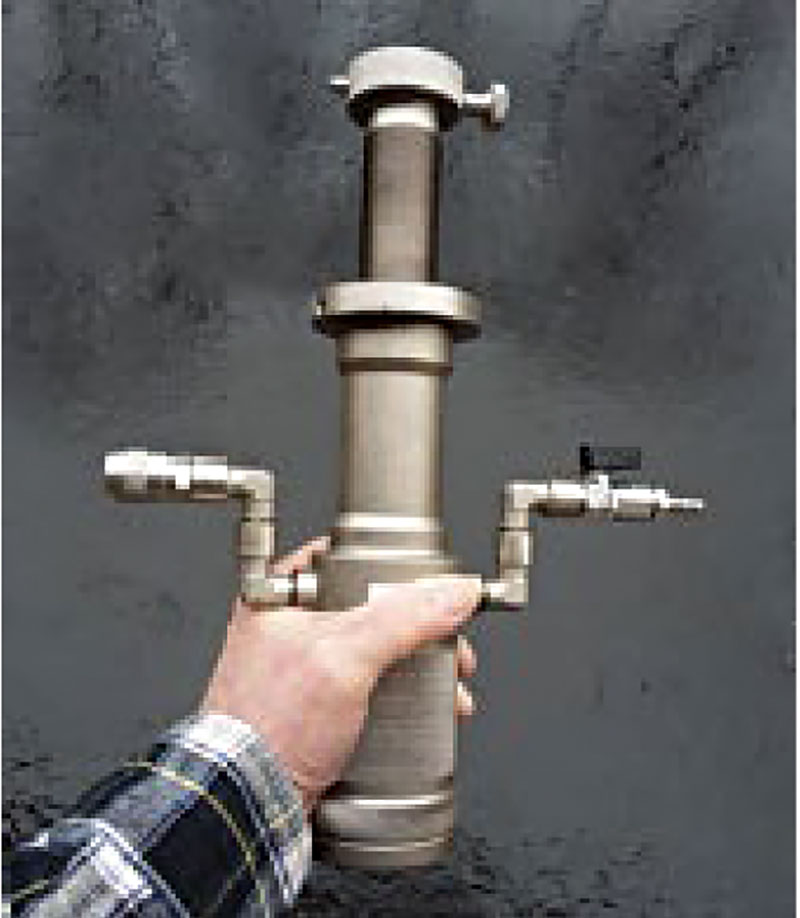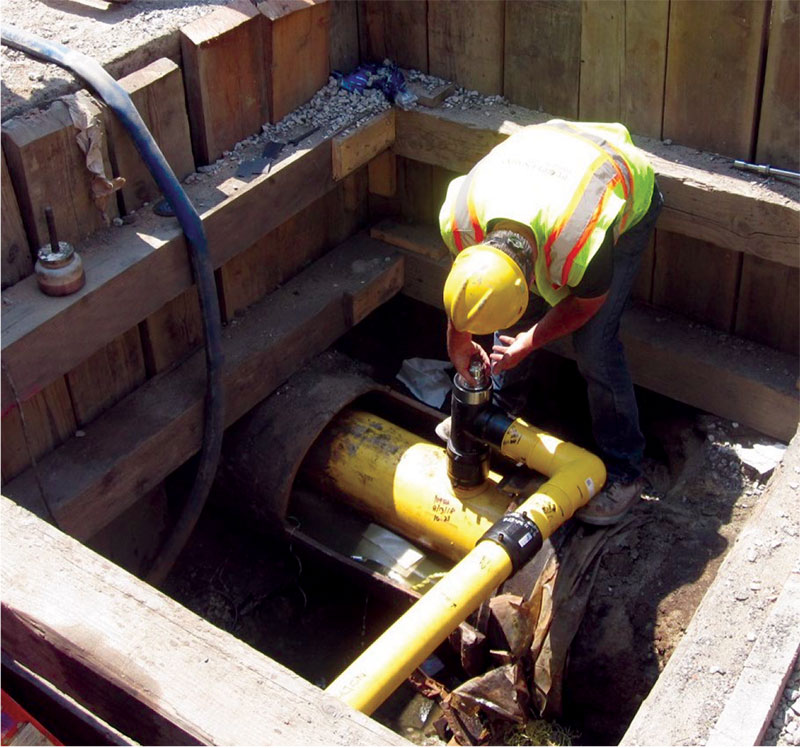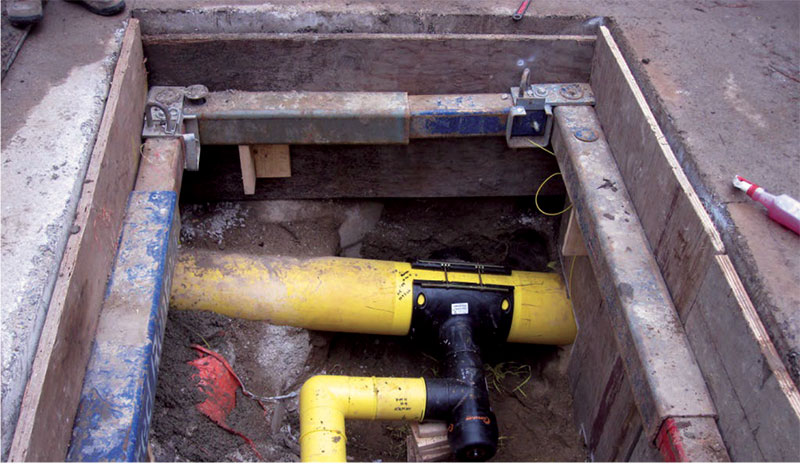September 2020, Vol. 247, No. 9
Features
Adjusting Costs with Large-Diameter Tapping Tees
By Julie Maupin, Peoples Gas, and Steve Gauthier, Energy Experts International
Peoples Gas is the oldest utility in the city of Chicago and delivers natural gas to about 870,000 customers within the city limits through 4,500 miles (724 km) of gas mains and 500,000 services. Since 2011, Peoples Gas has been pursuing an aggressive system modernization program.
This includes the replacement of 2,000 miles (3,200 km) of cast iron and ductile iron mains operating at 7 inches (178 mm) water column with modern polyethylene operating at 22 psi (1.5 bar). This program also includes relocating regulators and meters outside and installing excess flow valves in service lines and shut-off valves in readily accessible locations.
At the end of 2019, the program had retired 550 miles (885 km) of main, installed 1,036 miles (1,667 km) of distribution main, 21 miles (34 km) of high-pressure main, 78,000 services and moved 170,000 customer meters.
The total cost of large-scale infrastructure projects is dominated by labor and restoration expenses. Reductions in either of these areas can result in significant savings over the duration of the program, and early adoption can create a compounding effect.
Peoples Gas looks to reduce costs through adjustments in construction methods and adoption of tooling and technological advancements. Potential solutions are evaluated for applicability and suitability before moving to field trials. Field trials are the true litmus test where practicality is explored, field employee interest is gauged, and the range of applications is discovered.
One advancement the company has evaluated is the large-diameter, full-port, full-pressure, polyethylene (PE) tapping tee developed by Torre Gas, called Supraflow. Supraflow was developed in Europe as an alternative to squeezing pipe to install inline tees on larger-diameter mains.
It has been tested and qualified to relevant ASTM standards and each one is individually factory-tested to 225 psi (16 bar), 150% of maximum operating pressure.
The fitting is available with outlet diameter sizes of 3-, 4-, 6- and 8-inches (76-, 102-, 152- and 203-mm). The diameter of the main on which it can be installed is only limited by the commercial availability of branch saddles. Once installed on the main, the tapping operation is carried out under live conditions and in less than 15 minutes.
The fitting has been tested and rated for operation up to 150 psi (10 bar). The design of the fitting allows for the use of a single small excavation by eliminating a double squeeze and vent movers for back-fed mains. It has lower associated risks than shutdown operations.
The utility typically butt-fuses the Supraflow to an electrofusion branch saddle then installs the saddle on the main. It is possible to fuse the branch saddle, then electrofuse the Supraflow to the branch if the crew has an electrofusion clamp that can be adjusted to the clamp just outside of the coupling. Typically, the new pipe segment is joined to the Supraflow and pressure-tested prior to tapping.
One feature of the combination of a branch saddle and the Supraflow tee is the ability to install it 360 degrees around the main or the axis of the tee.
The tapping cutter inside is factory-assembled inside a traditional butt fusion PE tee. Much like a service tapping tee, the cutter is housed in the top of the fitting (Figure 1) and is driven down to perforate the active pipe, then withdrawn back into the tower. The coupon is fully retained in the cutter and the shavings from a 4-inch tap could fit on a quarter.
A squeeze-off operation on a larger-diameter main requires a distribution crew, equipment operator, two fusers and a large excavation. The tapping of the Supraflow tee can be completed by one person in a significantly smaller opening. PGL can use the compact Supraflow tapping tool with a maximum pressure of 30 psi (2 bar). (Figure 2).
This is especially useful in crowded underground areas with poor horizontal separation from other utilities. Although the tool is manual, operation takes less than 15 minutes and removes the need for a compressor.
Field Trials
Peoples Gas conducted four field trials on mains ranging from 6 to 12 inches (152 to 305 mm). All installations were to connect new services with large loads, though the Supraflow lends itself to system expansion and branch connections missed during the design phase.
Energy Experts International (EEI), the U.S. technical representative of Supraflow, was on site for installations and provided tabletop reviews and training of the procedure prior to any tapping. The avoided costs for labor, excavation and restoration were about $30,000.
Site 1 – 12- by 4-inch installation (Figure 3)
- Limited horizontal clearance for traditional hot tap, which requires 7 feet (2 meters).
- Eliminated two squeeze points and air movers, the need for a distribution crew and equipment operator, and a 16-foot (5-meter) opening.
- Less work performed to cut out the old 24-inch cast iron main into which the 12-inch PE was inserted.
Site 2 – 6- by 4-inch installation (Figure 4)
- Five- by 8-foot (1.5- by 2.5-meter) excavation was sufficient with Supraflow.
- Performing a traditional tie-in would have resulted in extending the opening an additional 10 feet (3 meters) to get the specified squeezing distance from joints and fittings. This would have also resulted in the loss of a large industrial customer.
Site 3 – 12- by 6-inch installation (Figure 5)
- Installation took place on a very busy one-way street.
- Supraflow installed in a 6- by 5-foot (1.8- by 1.5-meter) excavation instead of a 16- by 6-inch (406- by 152-mm) trench for a double squeeze off with the loss of a customer.
- No requirements for a formalized shutdown procedure, distribution crew or equipment operator.
- Small rotation of the Supraflow tee made it seamless to install the service horizontal from a main on an incline.
Site 4 – 8- by 4-inch installation
(Figure 5)
- Trench width only needed to be 5 feet rather than 12 feet (3.6 meters) for a double squeeze.
- No requirements for a formalized shutdown procedure, distribution crew or equipment operator.
- High-visibility project requiring a new gas service.
Conclusions
Peoples Gas conducted four successful field trials of the Supraflow large- diameter, high-pressure live PE Tapping Tee, with tapping time for each taking less than 15 minutes.
Each trial allowed for the use of a reduced size excavation, and the results showed decreased costs for small excavation and restoration, along with increased safety and reduced disruption to the public.
There was reduced need for heavy equipment and elimination of pipe squeeze tools.
Author: Julie Maupin, who has held several positions at Peoples Gas, is currently engineering manager and oversees the evaluation of emerging technologies, material standardization initiatives and development of testing protocols for new materials.
Steve Gauthier is the vice president & general manager of the Energy Experts International Midwest Region. He is a licensed professional engineer in the state of Illinois and a graduate of Stevens Institute of Technology with a bachelor’s degree in mechanical engineering. He earned his MBA from the University of Illinois.











Comments